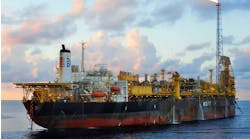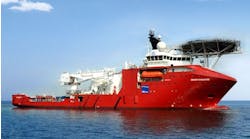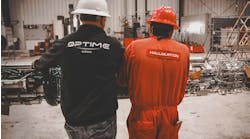APL gets Alvheim contract
Marathon Petroleum Norge AS, a subsidiary of the Houston-based Marathon Oil Corp., has awarded Advanced Production and Loading AS (APL) a Nkr400 million-contract to supply the turret mooring system for the Alvheim field FPSO. APL is an independent Norwegian company specializing in turret mooring systems.
The Alvheim field is on the Norwegian continental shelf west of Haugesund and close to the UK border in 125 m of water. Production from Alvheim is expected to reach more than 50,000 b/d by 2007. Alvheim is estimated to contain 200-250 MMboe.
The submerged.....
APL will supply a submerged turret production (STP) system for permanent mooring of theMST Odin as FPSO for the field, which will have a life of 25 years. The STP system will have 14 slots through the turret to accommodate risers and umbilicals for the initial subsea wells and for planned expansions.
The submerged turret production system for permanent mooring of the Odin FPSO on the Alvheim field will have 14 slots through the turret to accommodate risers and umbilicals for the initial subsea wells and for planned expansions.
The Odin FPSO will store 560,000 bbl of oil and, by means of a 12-line mooring system, will be moored in a passive mode. The mooring system is designed to withstand a 100-year storm with 14.6-m significant wave height.
APL has previously delivered four STP systems, of which two are mooring sister vessels to theOdin - one for the Statoil-operated Lufeng field in the South China Sea and one for the Shell-operated Pierce field in the UK North Sea. The two other STP systems in operation are the CNOOC-operated Wenchang and the Devon Energy-operated PanYu FPSOs in the South China Sea.
APL has contracts for 27 turret-mooring systems worldwide for FPSOs, FSOs, shuttle tankers, and standard trading tankers.
SUT subsea technology course
Forecasts indicate significant growth ahead worldwide for subsea development projects, and as the interest in subsea expands, so does the need for education and technology exchange. One forum serving that need is the Society for Underwater Technology, a professional society based in London with chapters around the world. The SUT promotes the further understanding of the underwater environment and encourages:
• Cross-fertilization and dissemination of ideas, experience, and information between workers in academic research, applied research and technology, industry, and government
• Development of techniques and tools to explore, study, and exploit the oceans
• Proper economic and sociological usage of resources in and beneath the oceans
• Further education of scientists and technologists to maintain high standards in marine science and technology.
One of the services SUT offers to the industry is a five-day intensive course on subsea technology. The course, which just completed its most recent quarterly session in Houston, is designed for a range of students, from engineers new to the offshore industry to those transferring from other disciplines within the industry and engineers who have worked in subsea previously but would benefit from a refresher course and exposure to the latest technology. Key supply and service companies, as well as operators, in the subsea sector present the course modules and host the students on their premises.
“SUT currently has about 1,600 members worldwide,” says Christopher Lindsey-Curran, who heads up the Houston chapter. “We started the Houston branch four years ago with 10 members and now have more than 300. In addition to the London office, we also have a busy office in Aberdeen, as well as Houston, Brazil, and Perth.”
While most of the subsea awareness course is in a classroom environment, the sessions include hands-on and visual components of technology and products destined for subsea service. Sample topics include field development planning, system engineering case studies, floating production systems, drilling equipment and dry trees, subsea tree and workover equipment, downhole and smart well equipment, systems integration, subsea control and distribution, control fluids, subsea processing and electrical, umbilicals, manifolds, flowline tie-in systems, and more.
“Training is very significant to us,” Lindsey-Curran says. “We plan to expand the subsea awareness course to other areas, such as subsea control systems. In fact, we have a subsea tieback course that we’re sponsoring in association with PennWell that will run just prior to PennWell’s Subsea Tieback Forum (in Galveston, Texas, March 1-3, 2005).”
In addition to the training courses, the SUT has found other ways to benefit the industry.
One thing we’re very proud of is that this year we’ve been able to start giving scholarships to undergraduates,” Lindsey-Curran says. “We gave three away this year and expect to grow that program next year. There will be a post-graduate one also - a named scholarship on behalf of Fugro.” For more information on the Societies activities go to www.SUTHouston.com.
Bohai Bay umbilicals
JDR Cable Systems Ltd. supplied dynamic catenary umbilicals to APL Norway, who installed them on two projects in China’s Bohai Bay - CFD 11, operated by Kerr-McGee, and BZ 25, operated by CNOOC/ChevronTexaco.
The JDR cables form the dynamic portion of an electro-optical network used to transmit medium voltage power and communications from the field’s FPSO to the wellhead platforms.




